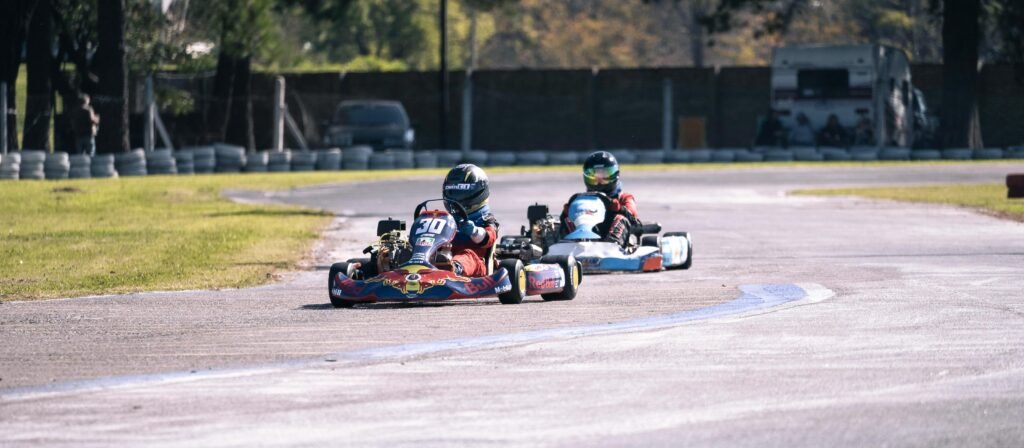Weather conditions play a pivotal role in kart racing, significantly impacting a driver’s performance, vehicle handling, and overall race strategy. From wet and rainy tracks to scorching heat and gusty winds, each weather scenario presents unique challenges that require drivers to adapt quickly and smartly. Understanding how to handle these varying conditions is essential for maximizing performance and staying competitive on the track.

In this article, we will explore how different weather conditions affect kart racing and provide insights into how drivers can adjust their techniques for each scenario.
1. Rain and Wet Tracks: Mastering Slippery Conditions
Driving in the rain is one of the most challenging scenarios in kart racing. Wet surfaces reduce tire grip, making it difficult to control the kart and forcing drivers to adjust their strategies significantly.

Impact of wet conditions:
- Reduced traction: Water creates a slippery surface, reducing the friction between the tires and the track, which can lead to sliding, spinning, or loss of control.
- Longer braking distances: With less grip, karts require longer braking distances, increasing the likelihood of overshooting turns if drivers don’t adjust in time.
- Hydroplaning risks: In heavy rain, water can build up between the tire and the track, causing the kart to lose contact with the road surface and resulting in a loss of control.
How to adapt:
- Use rain tires: Rain tires are designed with deep treads to channel water away from the tire’s surface, improving grip in wet conditions.
- Take a different racing line: Wet tracks require drivers to adjust their racing line. Instead of using the traditional line, which becomes polished and slippery in the rain, drivers often opt for a wider line with more grip.
- Smooth driving inputs: Sharp braking or aggressive acceleration can easily result in loss of traction. Smooth and gradual steering, braking, and throttle inputs are critical for maintaining control.
Key Takeaway: On wet tracks, drivers need to prioritize smooth driving and adjust their racing line for better grip, while rain tires are essential for handling slippery surfaces.
2. Hot and Dry Conditions: Managing Tire Wear and Engine Performance
Racing in hot weather creates a very different set of challenges. While the dry track provides excellent grip, high temperatures can affect both tire durability and engine performance.

Impact of hot conditions:
- Increased tire wear: Heat accelerates tire wear, as friction between the tires and the track generates excessive heat, causing the rubber to degrade faster.
- Overheating engines: Karts rely on airflow for cooling, and in hot conditions, engines can overheat if not properly managed, leading to reduced performance or even failure.
- Driver fatigue: Hot weather can cause dehydration and fatigue, reducing the driver’s reaction times and focus.
How to adapt:
- Monitor tire pressure: Heat increases tire pressure, which can affect grip. Drivers should adjust tire pressure before the race to ensure the tires perform optimally under hot conditions.
- Conserve tires: Avoid aggressive driving that causes excessive tire wear. Smooth cornering and braking can extend the life of the tires.
- Stay hydrated: Drivers must stay hydrated and manage their energy levels, especially in endurance races, to combat heat-induced fatigue.
Key Takeaway: Hot and dry conditions demand careful tire management and attention to engine temperature, while maintaining physical endurance is essential for optimal performance.
3. Cold Weather: Handling Low Temperatures and Slippery Tracks

In cold weather, tires and the track surface offer less grip, and it takes longer for both the tires and the engine to reach their ideal operating temperature.
Impact of cold conditions:
- Cold tires: Tires take longer to heat up in cold weather, reducing initial grip and making the kart feel slippery, especially in the first few laps.
- Lower engine performance: Karts operate best when the engine reaches a certain temperature. Cold weather means it takes longer for the engine to warm up, affecting power output.
- Reduced traction: Cold track surfaces provide less grip, making it harder for karts to maintain traction, especially during acceleration and braking.
How to adapt:
- Warm up the tires: Drivers should take their time in the opening laps to warm up their tires gradually before pushing for faster lap times.
- Softer tire compounds: In cold weather, softer tire compounds can offer better grip as they heat up more quickly and maintain better contact with the track.
- Smooth braking and throttle: Drivers should brake earlier and more gently, and accelerate smoothly to avoid slipping and sliding on the cold surface.
Key Takeaway: In cold weather, drivers must focus on warming up their tires and engine, while adjusting their driving style to account for reduced grip and slower tire responsiveness.
4. Windy Conditions: Dealing with Aerodynamics and Stability
Strong winds can affect the handling and performance of karts, particularly on exposed sections of the track. Crosswinds and headwinds change the way the kart behaves aerodynamically, influencing speed and control.

Impact of windy conditions:
- Crosswinds: Winds from the side can cause instability, especially in corners or on straights, making it harder to maintain a smooth racing line.
- Headwinds: A strong headwind can reduce a kart’s top speed on straights, making overtaking more difficult.
- Tailwinds: Conversely, tailwinds can increase speed, but they may also throw off braking distances and timing in certain sections of the track.
How to adapt:
- Adjust steering: In windy conditions, drivers may need to correct their steering more frequently to compensate for crosswinds that push the kart off course.
- Use drafting: Drivers can draft behind another kart to reduce the impact of headwinds. Drafting allows them to maintain speed and save energy, providing an opportunity for overtaking when they pull out of the slipstream.
- Monitor wind direction: Drivers must be aware of how the wind changes during the race and adjust their driving strategy accordingly, especially on straights and in corners.
Key Takeaway: Windy conditions demand precise steering adjustments and can be used strategically for slipstreaming. Drivers must remain vigilant about how wind impacts their kart’s stability and speed.
5. Mixed Conditions: Adapting to Changing Weather
Races that start in one weather condition and shift to another—such as from dry to wet or vice versa—present unique challenges. Mixed conditions often force drivers to adjust their strategies mid-race to adapt to changing grip levels and visibility.
Impact of mixed conditions:
- Variable grip: When parts of the track are dry and others are wet, grip levels can vary significantly from one section of the circuit to another.
- Tire choices: Deciding when to switch from slicks to rain tires (or vice versa) can be critical. The wrong tire choice can make a massive difference in speed and control.
- Visibility issues: As weather changes, visibility can worsen, especially in rainy or foggy conditions, making it harder for drivers to see the racing line and anticipate turns.

How to adapt:
- Flexible strategy: Drivers must be ready to adapt quickly, choosing the right time to pit for tire changes if necessary or adjusting their racing line to accommodate changing track conditions.
- Be cautious in tricky sections: Drivers should be extra cautious when approaching sections of the track that are slick or damp while maintaining speed on drier areas.
- Watch competitors’ strategies: Keeping an eye on what other drivers are doing in terms of tire changes and driving lines can provide valuable insights into adapting strategies mid-race.
Key Takeaway: In mixed conditions, flexibility is key. Drivers must be prepared to quickly adjust their driving style and tire choices as the track evolves.
Weather as a Decisive Factor in Kart Racing
Weather conditions play a crucial role in kart racing, affecting tire grip, vehicle performance, and race strategy. Whether you’re dealing with wet tracks, scorching heat, cold temperatures, or gusty winds, understanding how weather influences karting performance is essential for success.
Drivers must learn to adapt quickly to these changes, using different tires, driving techniques, and strategies to stay competitive and maintain control in any condition.
Embrace the challenge of karting in different conditions, and refine your skills to become a versatile and adaptable driver capable of handling whatever the weather throws at you!
